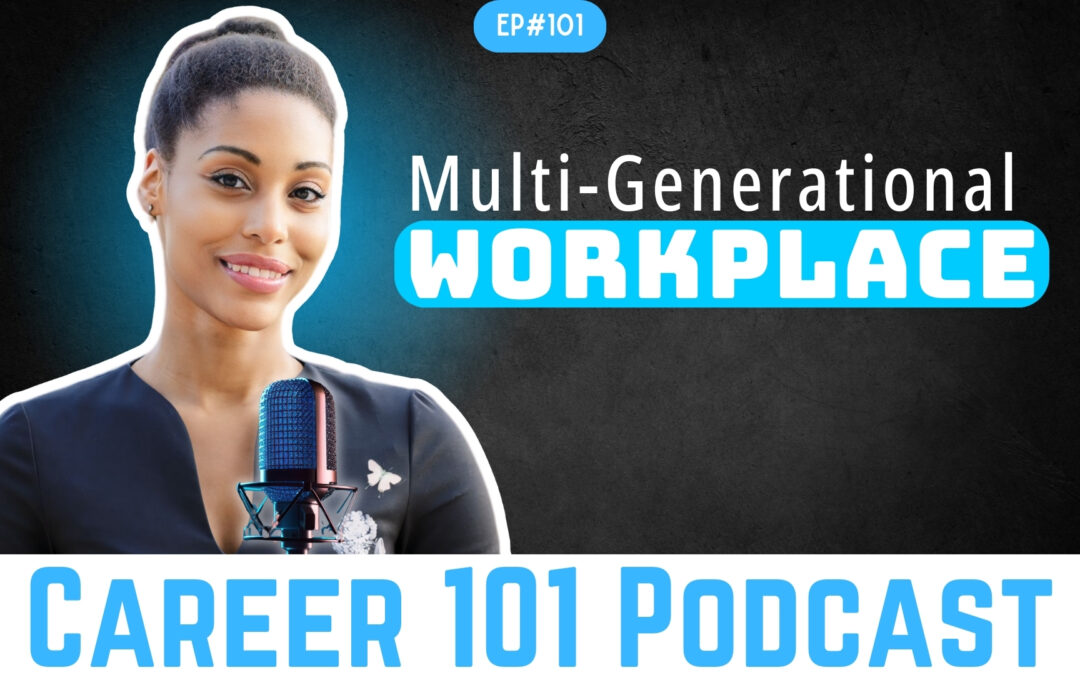Bridging the Gaps: Thriving in a Multi-Generational Workplace
In this episode, our host Porschia explores the challenges and opportunities that come with working in a multi-generational workplace, a dynamic environment where different age groups interact, collaborate, and sometimes clash.
If you’ve noticed generational misunderstandings impacting your workplace, you’re not alone. This conversation helps you recognize common generational stereotypes and conflicts, and how they might be affecting your team’s productivity and culture.
Porschia shares three actionable strategies to foster better collaboration across generations, emphasizing the strengths each age group brings to the table!
Through insights on effective communication, mentorship, and inclusive teamwork, this episode offers practical tools for building a cohesive, high-performing team within any organization.
Tune in for thoughtful advice on how to bridge generational gaps and create a positive, engaging workplace for all!
What You’ll Learn:
- How generational differences impact workplace communication, productivity, and culture.
- Common stereotypes about each generation and how they influence team dynamics.
- 3 practical strategies for bridging generational gaps and improving collaboration.
- Ways to leverage each generation’s unique strengths to enhance team performance.
- Why fostering an inclusive, multi-generational workplace can boost employee engagement and retention.
As a thank you for listening to this episode of the Career 101 Podcast, we are sharing our FREE master class – Career 911: Solving the Top 5 Challenges Executives and Professionals Have! It’s a training based on solving the common problems our clients have experienced to reach their goals. You can get access to the master class here!
Resources:
- Episode Transcript
Bridging the Gaps: Our Multi-Generational Workplace
Porschia: [00:00:00] Hello, I’m Portia Parker Griffin, and I wanna welcome you to the Career 1 0 1 Podcast, a place for ambitious professionals and seasoned executives who want an edge in their career. We’re talking about all of the things you were never taught or told when it comes to career growth, development, and change.
Now let’s get into it.
In today’s episode, we’re diving into a topic that affects every workplace, the multi-generational workforce with multiple generations working side by side. Understanding how to collaborate effectively is essential for success. We’ll break down the defining characteristics of each generation. Explore common stereotypes.
Porschia: Discuss sources of conflict and provide three key strategies for seamless [00:01:00] collaboration. We consult with our clients that are companies and organizations when they wanna make a big change in their performance, productivity, or culture within their workplace. This information is vital when it comes to attracting, engaging, and retaining top talent of all generations.
Talking about multi-generations in the workplace seems to be a hot topic and for good reason. Now, more than ever, companies need high levels of engagement to reach their goals and increase their profitability. So let’s start with understanding the predominant generations today. Today’s workplace is home to five distinct generations, each shaped by different historical events, technological advancements, and cultural shifts.
First, we have the traditionalists born between 1928 and [00:02:00] 1945. Sometimes traditionalists are called the silent generation. Traditionalists tend to value loyalty, discipline, and a strong work ethic. They often prefer hierarchical structures and are known for their respect for authority. My grandparents were in the traditionalist generation and there are a few traditionalists still working in the workforce today.
Second, we have the baby boomers born roughly between 1946 and 1964. Raised during a time of economic expansion, boomers are often seen as competitive, hardworking, and dedicated to their careers. Many prioritize face-to-face communication and value, tenure and experience. Many baby boomers are known for having a respect for hierarchy and being goal-driven.
Baby Boomers make up about [00:03:00] 21% of the US population, and that’s over 71 million people. What’s interesting is that today they estimate about 10,000 boomers are reaching retirement age every day With our clients, we tend to see that more boomers are continuing to work for fulfillment and to remain active.
Other boomers have told me that they’ve crunched the numbers and they simply can’t afford to retire, so they’re still in the workforce. Next, we have Generation X or Gen Xers born roughly between 1965 and 1980. Often they’re called the middle child of generations. Gen Xers grew up with increasing divorce rates and economic uncertainty, making them independent, adaptable, and skeptical of authority.
They appreciate work-life, balance, and value, efficiency, and freedom. [00:04:00] Gen Xers make up about 20% of the population in the US and that’s approximately 65 million people. Many of our clients who are Gen Xers tell me that they are very focused on their career and they plan to achieve certain milestones within the next decade.
After that, we have the millennials born roughly between 1981 and 1996. Millennials came of age during the rise of the internet and social media, making them tech savvy and collaborative. They tend to seek purpose-driven work, value, flexibility, and expect frequent feedback. Millennials make up about 22% of the US population, and that’s roughly over 72 million people.
Millennials recently surpassed baby boomers as the largest adult generation. It’s now [00:05:00] estimated that millennials make up 75% of the US workforce. Millennials are also considered the most educated generation because a large percentage have at least some college education. And finally, we have Generation Z or Gen Zs born roughly between 1997 and 2012.
The newest generation in the workforce, gen Z, has never known a world without smartphones. They are considered the first true digital natives. They are entrepreneurial and value authenticity and inclusivity. Gen Zs make up about 20.5% of the US population, and they are more ethnically diverse than previous generations.
While generational differences bring diversity, they can also create misunderstandings. Now we know that everyone is [00:06:00] a unique individual. But throughout research, they’ve noticed some commonalities among generations. We’ve also discussed some stereotypes or generalizations about each generation. It’s important to know that not everyone of a certain generation is going to fall into the stereotypes.
However, it’s important to understand what the stereotypes are so that you can facilitate change and avoid workplace conflicts. Here are some of the common generational stereotypes.
Traditionalists are often perceived as rigid, resistant to change, and overly formal. Some may believe that they struggle with technology and prefer outdated methods of communication.
Baby boomers are sometimes viewed as workaholics who prioritize career over personal life. They may be seen as resistant to new technology and unwilling to embrace [00:07:00] change. Baby boomers have also been stereotyped as blindly trusting organizations and established processes even to their own detriment.
Some have noted that boomers can be judgmental of others and not innovative.
Gen Xers are often stereotyped as cynical, skeptical of authority and overly independent. Some may see them as less engaged in teamwork compared to younger generations. Gen Xers are often stereotyped as pessimistic lone rangers who don’t collaborate with others.
The Career 1 0 1 Podcast is brought to you by Fly High Coaching, where we help our clients soar to their full potential executives and leaders are setting out to achieve their company goals, but without the right support. It can be difficult, if not impossible. Employee performance, productivity, and company [00:08:00] culture all affect organizational revenue and profits.
We offer customized consulting, coaching, and training solutions and can serve as your external talent development partner. Check us out on our website, fly hi coaching com.
Millennials are frequently labeled as entitled, overly reliant on technology and in need of constant validation. They’re sometimes perceived as job hoppers who lack company loyalty. Millennials are often stereotyped as being lazy and having poor communication skills with others.
Gen Zers are often criticized for having short attention spans, being too reliant on social media and expecting rapid career advancement without paying their dues. Some believe that Gen Zers struggle with in-person communication due to their digital upbringing. [00:09:00] Gen Zers are also stereotyped as multitasking too much and being addicted to technology.
They’ve also received the label of Beam Job hoppers.
These stereotypes can lead to miscommunication and tension in the workplace. For example, a Gen X manager may prefer concise email communication. While a millennial employee may expect more collaborative and immediate responses via instant messaging or slack. Additionally, a baby boomer may value long work hours while Gen Z employees might prioritize mental health and remote work options.
When we work with companies, we help them create solutions to any challenges they’re having when it comes to the different generations in the workforce. I often find that multi-generational workplace issues can be an undercurrent causing [00:10:00] miscommunication, conflict, lower levels of performance, and decreased revenue.
A company’s custom solution might include a combination of coaching, consulting, and or training. Because I don’t know the specifics and haven’t done an organizational assessment for your company, I can’t tell you exactly what I would recommend. However, I wanna provide three general tips for successful multi-generational collaboration.
Number one is to embrace open communication, encourage transparent and respectful conversations. Different generations may prefer different communication styles. So establish norms in your company that work for everyone, whether it’s face-to-face meetings, emails, or instant messaging. Ensure that all employees feel heard and understood.[00:11:00]
Number two, you wanna leverage strengths across generations. Each generation brings unique strengths to the table. Boomers and traditionalists offer wisdom and experience. Gen Xers provide problem solving skills. Millennials bring innovation and teamwork, and Gen Z introduces fresh digital perspectives.
Encourage knowledge sharing through mentorship programs or reverse mentoring where younger employees teach older colleagues about new technologies. Number three, foster a culture of respect and inclusion. Instead of focusing on generational differences, emphasize shared goals and values, encourage collaboration through team building exercises and cross-generational projects, promote workplace flexibility to accommodate different work styles and preferences.
The multi-generational [00:12:00] workplace presents both challenges and opportunities by understanding generational perspectives. Debunking stereotypes and prioritizing open communication businesses can create a more cohesive and productive work environment. If you’re listening to this and you know that your team or your organization needs to make a change when it comes to engagement of employees and different generations.
We can help. Feel free to reach out and we can schedule a strategy call to determine one shift you can make right now to change the performance of your employees.
This episode was brought to you by the Brave Bird Career Alliance, the go-to membership designed for seasoned executives and ambitious professionals with everything you need for career planning, strategy, training, and support. [00:13:00] Thank you again for listening to the Career 1 0 1 podcast. I hope you have at least one key takeaway that you.
Can use in your own career. If you enjoyed hanging out with us, please rate, subscribe, and share this podcast. Until next time, here’s to your success.


